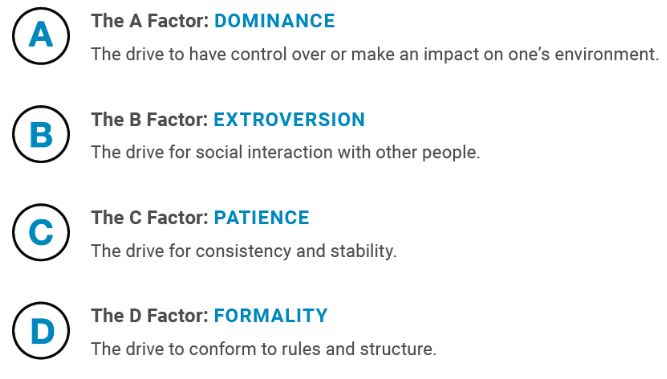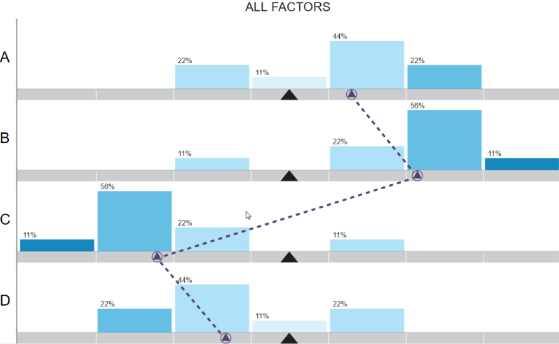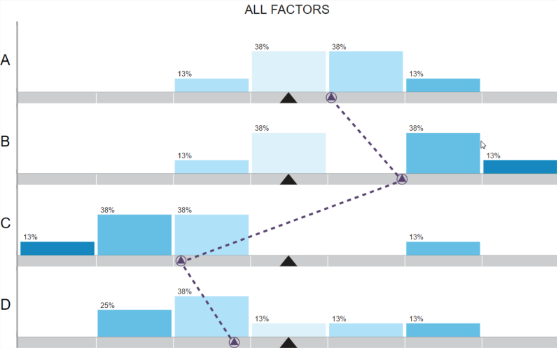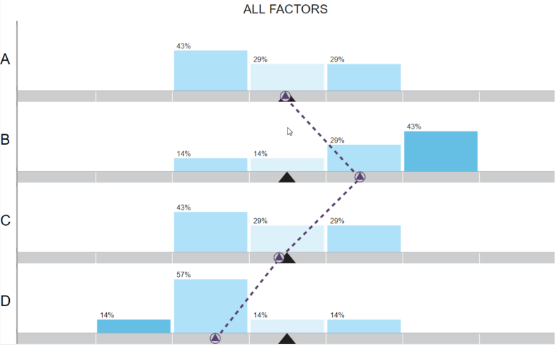The behavioral patterns of high-performing teams
Are all high-performing teams created equal? Find out in this e-book.
Contents
Some teams flourish while others flounder. As a leader (or someone helping leaders), it’s your job to figure out why.
The essential question is: How can we get “the right people on the bus”?
Conventional wisdom dictates that you need to get people with the right KSACs—knowledge, skills, abilities, and competencies. So companies search high and low for people with the right degrees, the right qualifications, the right industry knowledge, and the right set of experiences.
But with the war for talent limiting how many strong candidates recruiters can find, spotting and attracting people with the right pedigree is a Sisyphean challenge.
Fortunately, there are better predictors of on-the-job success: how people think and work.
Behavioral patterns trump skill sets.
Ultimately, a team’s success is less about the skillsets of the people who join the team and far more about the behavioral proclivities of the team as a whole. When a team has the right behavioral tendencies for the task at hand, they’re able to develop the specific skills required to accomplish goals.
The inverse, however, is rarely true: Just because a group has a certain set of skills, that doesn’t mean they’ll be able to adjust their behaviors to fit the task at hand.
The business strategy and the team’s goals will dictate what kind of behaviors the team needs. If the organization in question is a startup or disruptive new technology, you’ll want to hire people who need freedom from repetitive tasks, because the pace will be frantic. But members of the finance team at that same company need to be wired differently to protect the company from risk; they should enjoy following established guidelines. .
Of course, human behavior is complex and nuanced. It can be hard to understand and measure a single individual’s behavioral pattern, let alone look at the aggregate behavioral patterns of a team.
However, if you have a psychometric tool in place, you can look at individual and teams’ aggregate behavioral patterns and accurately analyze entire teams’ behavioral drives.
With that in mind, The Predictive Index® looked at three teams who have seen enormous business success, and then we aggregated the data to examine the teams’ behavioral patterns.
Background on the PI Behavioral Assessment™.
There are many personality and behavioral assessments out there. Myers-Briggs, DISC, The Winslow Personality Test, and the Holtzman Inkblot tests are some of the most well-known. But most behavioral assessments aren’t purpose-built to evaluate people’s key behavioral drives in the workplace.
The PI Behavioral Assessment was created to evaluate people’s behavior at work—both their inherent behavioral drives and their perceptions of what behaviors are expected of them. PI allows you to see an individual’s behavioral pattern and gives you access to a team’s aggregate behavioral pattern.
Some foundational understanding of this behavioral assessment is key. PI’s behavioral assessment measures four behavioral factors (also known as “drives”) in people. Each factor is denoted by a letter.

Here’s an example of what an individual’s behavioral pattern could look like:

Note the black triangle at the center of the graph, also called the midpoint; this marks the midpoint. Factors to the right of the midpoint are considered high and to the left are considered low. The further a factor lies from the midpoint, the more pronounced that behavior is.
The person with the pattern shown above is very independent (A), moderately reserved (B), and moderately driving (C). Since the D falls on the midpoint, this person’s formality is “situational”—depending on the situation, they can be flexible or precise.
What’s interesting to note when looking at these behavioral assessments is that you’ll never see all factors on one side of the midpoint or the other. There’s a balance of drives on each side of the midpoint.
What results are factor combinations, which is how a factor falls in comparison with another. Factor combinations are very telling. In our example above, we see that the widest factor combination for this individual is A over C, which indicates that they’re very proactive and have a strong drive to get things done.
Here are three more patterns. As you can see, each combination of drives is different.

The group’s behavioral analytics
The insight doesn’t end with individual behavioral patterns. You can also overlay individuals’ behavioral drives on top of a single chart of factors and identify aggregate behavioral patterns for the team. Here’s a look at the aggregate behavioral pattern of the marketing team at PI, for example:

As you can see, on the whole, this group is higher on dominance (A) and extroversion (B) and lower on patience (C) and formality (D). For a team that is constantly innovative and driving change, this pattern works well.
We wanted to analyze behavioral patterns of some of the high-performing teams at a few PI client companies and gather input from those companies’ leaders about why those patterns work so well.
Factor combination analysis:
The biggest Factor Combination for the PI team is “B over D” (extroversion over formality). People with this factor combination tend to be extraverted, friendly, and informal. While this team might be open in expressing their ideas, they may not present an idea that’s fully baked.
Indeed, those traits describe PI’s marketing team well.
Year Up: “We’re a people-centered organization.”
Year Up’s mission is to “close the opportunity divide by providing urban young adults with the skills, experience, and support that will empower them to reach their potential through professional careers and higher education.” Founded in Boston in 2000, Year Up now runs programs in 18 major metropolitan areas throughout the U.S.
Each of those major metro areas has their own sales teams, who work with corporate partners to develop partnerships and internships. Because each of the 18 metro areas has its own sales teams, we wanted to focus on the top three teams to see what their behavioral patterns look like.
Kailey Cartwright is Year Up’s senior director of staff learning and oversees the use of PI at the organization. She used PI tools to provide us with the aggregate patterns of three of their top-performing sales teams—Boston, New York, and San Francisco Bay. Here are what those three patterns look like:
Boston:

New York City:

Bay Area:

As you look at the patterns of Year Up’s best-performing sales teams, something becomes immediately evident—across the board, their strongest factor is extroversion (the B factor).
Cartwright (who happens to have a very low amount of the extroversion drive) offered this hypothesis on the behavioral patterns of these high-performance sales teams:
“We’re a people-centered organization and our sales folks need to go out there and sell an idea to a company that may not yet have considered working with young people that don’t have a typical path. That kind of extraversion is really important. Their whole job is to talk to people, and I’m glad it’s not mine!”
As you’ll see in the pages ahead, in many sales organizations, dominance (the A factor) is a key behavioral drive for salespeople.
One of the tell-tale traits of high-dominance people is that they like to put their mark on things and blaze new trails. But interestingly, the dominance drive is quite moderate within Year Up’s most successful sales teams. Cartwright explained why dominance doesn’t seem to be a critical trait on the most successful Year Up sales teams:
“We do have pretty clear sales tactics and guidelines. There’s not a lot of reinventing the wheel or imposing your own style. We ask our sales reps to approach things a certain way, so super high A might not be required as much in these sales roles as those at other organizations.
Factor combination analysis:
At Year Up, the biggest Factor Combination is B over C (extroversion over patience). This Factor Combination generally results in people who are quick to connect with others, persuasive, and are enthusiastic communicators. It’s easy to imagine that this serves the Year Up sales team well.
Paradigm Partners: “The approach we deliberately took was to balance out the very wide patterns of the partners.”
Paradigm Partners was founded by Mike Hogan and Mark Swansburg in 2010. It’s solutions center are doing services, providing LED lighting, solar, and other renewable and distributed generation solutions. Paradigm Partners is technically broken down into three companies: 1) corporate; 2) commercial roofing; 3) energy efficiency.
The energy efficiency company has had the best revenue performance of the three entities—with a compound average annual growth rate of 50.3 percent over the last six years. The team’s revenues have gone from $1 million in 2013 to $13.8 million in 2018.
Here’s a look at the team’s behavioral pattern:

This is what’s known as a “skinny pattern” or a “situational pattern,” meaning that the behavioral drives are fairly close to the midpoint. This means the team can adapt its behaviors depending on the situation.
Indeed, building a team with a situational pattern was very much Hogan and Swansburg’s intention. As Hogan explained:
“We want a vertical team pattern that is situational. The approach we deliberately took was to balance out our very wide patterns.” (Both Hogan and Swansburg are very high dominance, and high extraversion as well. Conversely, they are low patience and formality.)
They’ve explicitly built a team that offsets their personal behavioral patterns. Hogan explained that he thinks creating a team with situational behavioral drives has the added advantage of “minimizing the emotions of everyday experiences at work.” He believes this helps them focus on the work “without taking things too personally.”
Factor combination analysis:
While Paradigm Partners has a skinny pattern, the widest factor combination is A over B (dominance over extraversion). People with this factor combination are generally very direct and pointed, and they tend to be more task-oriented than people-oriented.
dataxu: “High As are beneficial for salespeople due to their natural desire to exert their influence over people and things.”
dataxu builds software that helps successful marketing professionals use data to improve advertising. Tiffany Mosher is dataxu’s chief people officer. She recently went through the exercise of analyzing the behavioral patterns of their top five highest revenue-attaining sales reps. Here are the results:

The aggregate pattern of these five sales reps mirrors what The Predictive Index calls a “Captain” Reference Profile. Captains tend to be independent and strong-willed, and they connect easily with other–and their ideas are usually both innovative and effective. As Lisa McAuliffe, dataxu’s director of people ops explained:
“For sales, Captains are undaunted by failure, and this is crucial since it takes a lot of nos to get to a yes. Thinking outside the box is also helpful for our sales team since when the traditional pitches and approaches don’t work, they need to find an alternative and keep plugging.” Furthermore, she explained, “High As are beneficial for salespeople due to their natural desire to exert their influence over people and things. They’re not going to like losing, and they’re going to want to win people over to their way of thinking.”
Interestingly, when dataxu looked at their lower-performing sales reps, they had lower dominance (A) and extraversion (B) drives.
Another key part of a Captains’s behavioral pattern is low patience (the C drive), and this what they see in dataxu’s top-performing sales reps as well. As McAuliffe put it, “Lower Cs move faster and can adapt more easily and frequently to a changing environment, which is very beneficial in dataxu’s culture.”
Factor combination analysis:
dataxu sees its most defining factor combination in its A over C drive (dominance over patience). These patterns thrive under pressure, are often change agents, and are proactive. You can easily imagine these traits serving enterprise sales reps very well.
Conclusion
When you think about it, the logic of molding together a team based on their behavioral drives is somewhat blinding in its obvious benefits. There are several keys, however, to implementing this approach effectively.
- Be sure you know what behaviors you need, given the strategic activities that are critical to the group’s success. (One way to do this is with PI’s Strategy Insights tool.)
- Understand that the behaviors needed in one situation can be very different from the behaviors needed in another. PI has conducted more than 100 validity studies to analyze whether there are statistically relevant correlations between behavioral drives and employee performance on sales teams. We’ve found that very different patterns are successful at different companies. Year Up and dataxu are a perfect example of this.
- Have an unbiased, validated instrument for assessing people’s behavioral drives.
- Make sure you have a user-friendly way to analyze the behavioral data you’re collecting.
- Educate the people within the company about why and how you’re using behavioral data. We have a saying at PI that “Every pattern is beautiful.” But when it comes to performance, aligning the right behavioral drives with the right roles is what will get you the business results you crave.